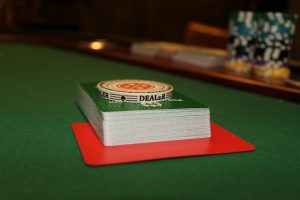
Imagine this scenario: your friends invited you to a poker night. There's going to be food, booze, and poker. You want to join in on the fun, but you have no idea how to play poker. Well don't worry about missing out on beer and bonding: I'm going to teach you how to play Texas Holdem, so you too can partake in the poker festivities.
Texas Holdem (aka Texas Hold 'Em) is the poker game played most often at casinos and home poker games. Becoming a great Holdem player generally takes years of practice and studying, but learning how to play doesn’t take long at all.
In this article, I’ll walk you through the Texas Holdem rules. After studying this article, you’ll be able to play online, at a casino, or with your friends. Hooray! Remember, just knowing the rules won’t make you an outstanding player, but you’ll be able to play, and you can get better through practice.
How to Win Texas Holdem
The goal in poker is to win as many poker chips as you can, one hand at a time. Typically, different chips will represent different denominations of money.
You can win chips by having the best 5-card hand or remaining in a hand and having all the other players fold, meaning they give up instead of risking additional chips.
The 10 Possible Poker Hands
In Holdem, each player is dealt 2 cards (“hole cards”). Then, up to 5 community cards will be flipped in the center of the table. I’ll thoroughly explain the concept of community cards later, but Texas Holdem rules dictate that your best 5-card hand out of the 7 total cards is your final hand.
These are how all the different poker hands rank. The Royal Flush is the best hand and the worst is “high card.”
#1: Royal Flush: A, K, Q, J, 10 all the same suit (all clubs, all diamonds, all spades, or all hearts)
#2: Straight Flush: Five cards in a sequence (example: 5, 6, 7, 8, 9), all the same suit
#3: Four of a Kind: Four cards of the same rank (example: four kings or four 8’s)
#4: Full House: Three of a kind and a pair (example: three jacks and two 7’s)
#5: Flush: Five cards of the same suit (example: five clubs or five hearts)
#6: Straight: Five cards in a sequence but not of the same suit (example: 7, 8, 9, 10, J)
#7: Three of a Kind/A Set: Three cards of the same rank (example: three 5’s or three kings)
#8: Two Pair: Two different pairs (example: two 6’s and two 9’s)
#9: Pair: Two cards of the same rank (example: two queens or two 10’s)
#10: High Card: If you haven’t made any of the above hands, then your highest card determines the strength of your hand. (Example: if your highest card is an Ace, you have Ace high, and you would beat another hand in which the highest card was a King and none of the other hands were made.)
If multiple players have hands that are ranked the same, the best hand is determined by the highest card within the hand.
For example, if each player has a pair, then the highest pair wins. If somebody has a pair of 7’s and somebody has a pair of 5’s, the player with the pair of 7’s has a better hand. If two players have a pair of 7’s, then the player with the highest other card wins.
If you're comparing two straights or flushes, then the player with the highest card within the straight or flush has the better hand.
If you're comparing two full houses, the player with the highest card in the three of a kind has the better hand.
In most hands of Holdem, the winning player will only have a pair, but if you play long enough, you'll see every type of hand.
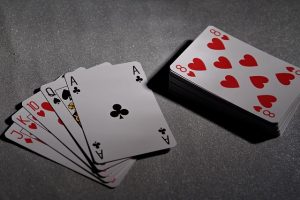
A straight!
Texas Holdem Setup
Holdem can be played with 2-10 players at a single table. Players sit around the table. Before beginning playing, each player purchases his chips.
In a home game or tournament, everyone typically starts with the same number of chips. Usually, each player will put in the same amount of money and get the same number of chips. For example, everyone may put in $40 and get $2,000 in chips. At a home game, you can decide if the winner (person who ends up with all the chips or the most chips) takes all, or if you’ll end up dividing the money among the top 2-3 finishers. Each tournament has its own guidelines.
At a regular casino game, the number of chips you get is based on your buy-in (the amount of money you give the dealer to receive your chips). If you spend more than the minimum buy-in, you’ll get more chips. If you buy in with $100, you’ll get $100 worth of chips. If you buy in with $200, you’ll get $200 worth of chips. At most casinos, there will be a minimum and maximum buy-in. Generally, the minimum buy-in will be 50 or 100 times the minimum bet.
The Dealer Button
At a home game, the dealer button is placed in front of the person who will play the role of the dealer for that hand and bet last after the initial round of betting. After each hand, the dealer button moves to the left.
At a casino, there will be a casino employee who will deal each hand, and the dealer button is solely used to determine who will bet last. Again, after each hand, the dealer button moves to the left.
Here’s what the dealer button looks like:

John Wardell/Flickr
If you’re playing a home game and don’t have an official dealer button, you can use any object to function as the dealer button. Just make sure not to use one of the same color chips that you’re using to place bets, so you don’t confuse the dealer button with a bet.
The Blinds
Blinds are the initial bets at the table. At the beginning of each hand, two players will post bets before any cards are dealt. These bets are referred to as the small blind and the big blind. The player to the left of the dealer button posts the small blind and the player to the left of the small blind posts the big blind. To post your blind, just place your blind in front of you on the table.
The big blind is the minimum bet after cards are dealt, and the small blind is half of that. In casinos, at the tables with the lowest minimums, small blinds are usually $1 and big blinds are $2. These games are referred to as “$1-$2 holdem.” Most casinos will also offer “2-4 holdem” and “3-6 holdem.” The first number is the small blind and the second is the big blind.
The purpose of the blinds is to stimulate betting. The blinds guarantee that there will be chips to win in each hand. Also, extremely conservative players are forced to make bets and can't just play for hours without risking any chips.
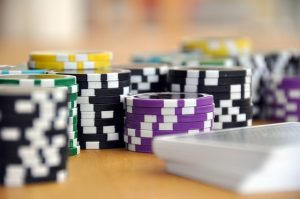
Betting Rounds
Texas Holdem involves four different rounds of betting. In each round, you normally have 3 options: you can fold, raise, or call.
If you raise, you increase the bet by at least the big blind. In no limit poker, the most common type for casinos and home games, you can bet up to all of your chips. If you bet all of your chips, that’s called going all-in. In limit poker, you can only raise by a predetermined maximum amount (normally twice the big blind), and there’s only a certain number of raises allowed per betting round (usually 4-5 bets per round).
If you fold, you’re giving up your hand instead of betting additional chips. When you fold, you put your cards face down in the center of the table. Never show your cards to anybody else, even when you fold.
If you call, you’re matching the last bet. If somebody bets $2 and the next person raises to $8, you have to bet $8 to call.
Additionally, if nobody has bet in a round, you can “check.” If you check (just say “check” or knock on the table), you’re keeping your hand and going to the next person without placing a bet. Typically, people check if they have a weak hand or they want the other players to think they have a weak hand (they’re trying to get other players to bet). You can also check if you’re the big blind and nobody has raised the big blind by the time betting action reaches you.
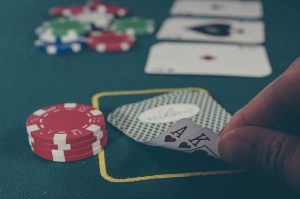
Betting Round 1: The Pre-Flop
The pre-flop betting round happens after each player receives his 2 cards and before any community cards are turned. Cards are dealt to the left (clockwise), one at a time, starting with the small blind.
Betting action starts to the left of the big blind. That player has the option of calling the big blind, raising, or folding. After each person has had a turn and all remaining players have bet the same amount, the betting round is over. If somebody raises, the next person has to call the raise, raise again, or fold.
If nobody raises the big blind, the big blind, who is the last person to act, can check and the betting round will be completed. But the big blind still has the option to raise. If he raises, then the remaining players will have to call, raise again, or fold.
Players bet by placing their chips in front of them. At the end of the round, all the chips that have been bet go into the center of table and are referred to as “the pot.”
At any point during any of the betting rounds, if all players fold, then the last remaining player wins the pot and the hand is completed. You start a new hand instead of continuing with one player.
Betting Round 2: The Flop
Three community cards are flipped. Every time community cards are flipped, the dealer should use a “burn card.” The burn card is the very top card on the deck. The burn card will be placed face down, and then the next three cards will be placed face up in the center of the table and will be the flop. The flop is the first three community cards.
After the flop is dealt, there’s another betting round. Action will start with the first remaining player to the left of the dealer button. The same betting rules apply: players can bet, fold, or call. If nobody has placed a bet, a player can check. Again, once each player has had a turn and everyone has bet the same amount, the betting round is completed.
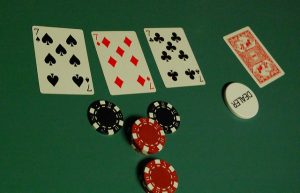
If you have the final 7, this is a very lucky flop! (auddess/Flickr)
Betting Round 3: The Turn
The dealer burns a card and then flips the top card next to the flop. The turn is the fourth community card. Then, there’s another round of betting. All the same betting rules apply. Again, action starts with the first remaining player to the left of the dealer button.
Betting Round 4: The River
After burning a card, the dealer flips the top card next to the turn. The river is the last of the five community cards. Then, there’s one final betting round. All the same rules from the previous betting rounds are used. If there’s more than one hand remaining at the end of the round, there’s a showdown.
The Showdown
In a showdown, the remaining players show their hole cards, and the best hand wins the pot. The best hand is determined by comparing each player’s best 5-card hand from their 2 hole cards and the 5 community cards. If their hands are ranked the same, the player with the highest card within the hand wins.
If the players have identical 5-card hands, then the players will split the pot.
Also, if you don’t want to show your cards, you can “muck” your cards (place them face down in the center of the table) and automatically lose. You can do this if another player shows a better hand and you don’t want the other players to know how bad or good your hand was.
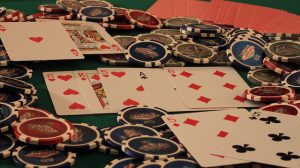
In the showdown, you put all your cards on the table. Literally. (Big Daddy Brent/Flickr)
How to Play Texas Holdem: Summary
In Holdem, every player gets two cards, called “hole cards,” and the rest of the cards are “community cards,” which means they’re used by each player to produce the best possible five card hand. After the blinds are posted, each player is dealt two cards face down. Cards are dealt one at a time, clockwise, starting with the small blind.
After everyone looks at their hole cards (never show your cards to anyone else), there’s a round of betting followed by “the flop.” For the flop, three cards are flipped from the top of the deck in the center of the table. After the flop, there’s another round of betting.
Then, there’s “the turn.” For “the turn,” one additional card is flipped and placed next to the last card of the flop. Then, there’s another round of betting.
Finally, there’s “the river.” For the river, one last community card is flipped and placed next to the turn. The flop, turn, and river are the five community cards. Players use their hole cards and the community cards to determine their best 5-card hand. After the river, there’s one final round of betting.
If there’s more than one player remaining after the final round of betting, players show their hole cards, and the best 5-card hand wins the the pot. If all players fold before the end of the last betting round, the last remaining player wins the pot.
Texas Holdem Rules Video Tutorials
Here are a few video tutorials so you can see the Texas Holdem rules we just discussed in action.
This first video quickly goes through the Holdem rules in under four minutes:
This video is slightly longer and provides more explanation of how to play Texas Holdem:
Finally, this video takes you through a complete hand of Holdem, discusses some basic strategy, and shows how you can lose with a seemingly great hand:
4 Very Basic Texas Holdem Strategies
Now that you've got the basic Texas Holdem rules down, it's time to start thinking about strategy. As you become a better player, you can vary your play and develop an individual style, depending on what works best for you. However, following these strategies as a beginning player will normally give you your best odds of winning or minimizing your losses. Remember that these are just general guidelines for beginners to simplify the game.
Play Tight (Especially Pre-Flop)
You should only place a bet pre-flop if you have a good starting hand. Generally, good starting hands are pairs, at least one Ace, or two face cards. If you’re in the small blind, if there isn’t a raise, it’s typically in your best interest to call the big blind and see the flop.
After the flop, don’t bet or call unless you have at least a pair. One notable exception is if you have at least 4 of the same suit or 4 in a sequence. Then, you have a decent possibility to make a flush or a straight. But if there’s a big bet or raise ahead of you, you may not want to call just to chase a flush or a straight. If it’s a small bet, it’s probably worth it to call.
Play Aggressively When You Have a Good Hand
This means that if you have a good hand, you should raise or bet. If you have a good hand pre-flop, raise 2-3 times the big blind. If you have a good hand post-flop, raise at least half of the pot. A good hand post-flop is at least top pair, meaning that one of your hole cards pairs with the highest ranked community card.
If you have a good hand post-flop, don’t just check or call. You should bet or raise. You can try to get fancy and check raise, meaning that you check, and then after a player bets, you raise his bet. But normally only more advanced players use this move.
If You’re the Dealer, Use Your Position to Your Advantage
If you’re on the button (the dealer) or close to it, you can decide what to do based on the other players’ decisions. If everyone in front of you checks, it’s possible that nobody has a good hand and you can try to take the pot by betting. The assumption being that if you bet, everyone else will fold. If multiple people in front of you bet or raise, you can assume that somebody has a strong hand, and you should only call or raise if you have a very strong hand.
Don’t Let the Outcome of Previous Hands Determine How You Play Your Current Hand
In poker, even if you make the right play, it’s possible for bad things to happen. For example, if you fold a 5-7 pre-flop and three 7’s come out on the flop, that doesn’t mean that you made the wrong decision, especially if there was a raise before you folded. The odds of three 7’s coming out on the flop were incredibly low.
Similarly, if you bet a good hand on the turn, then a weaker hand calls and ends up beating you by getting a lucky card on the river, you didn't make the wrong decision when you bet after the turn.
It's important not to let unlucky or lucky outcomes in previous hands influence your decisions. Focus on making the right play in that situation, and you'll give yourself the best chance to win.










